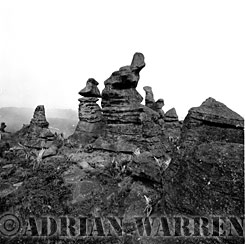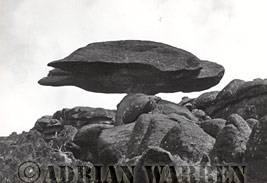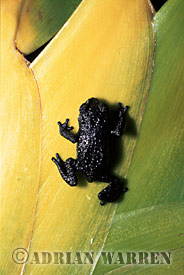|
THE STORY

Rock Shapes, RORAIMA's Summit |
Their first impression of the
summit was one of inability mentally to grasp their surroundings.
They appeared to have entered a strange country of nightmares, a wildly
fantastic landscape. All around them were rocks and pinnacles that
seemed to defy gravity and challenge imagination. Rock shapes sculptured
in the form "of caricatures of faces, of animals, of umbrellas,
tortoises, churches, cannons, and of innumerable other most incongruous
and unexpected objects". Between the rocks they noticed level
spaces of pure yellow sand, with stream-lets and little waterfalls,
and marshes with low, bristling vegetation. The first signs of animal
life were large lizards that skittered from rock to rock, and the
'pipping' sounds of frogs. |
|
The summit of Mount Roraima turned out to
be a harsh but beautiful world above the clouds. Im Thurn and Perkins
had no sooner accomplished their historic first ascent of Roraima
than a thick mist engulfed the summit, obscuring any view of more
than fifty metres or so, and therefore limiting their exploration.
After a very short time, the successful explorers began their descent,
leaving it for future expeditions to carry out more detailed surveys
of the mysterious plateau.
|

Turtle Rock, RORAIMA's Summit
|

Oreophrynella quelchii
|
The first scientific exploration of Roraima, by Messrs. McConnell
and Quelch, took place ten years later, in 1894, and was followed
soon afterwards by a second expedition by the same two men. They reaped
a wonderful harvest of curious and unique new plant and animal species,
many of which were to bear the names of their discoverers. It took
many years, however, to work through, and to catalogue, their collections.
There were no dinosaurs, of course; neither were there any animals
larger than a Coatimundi. The animals that were found showed a high
degree of melanism: black lizards, black frogs, black butterflies.
Why black? Perhaps to aid in heat absorption on this chilly mountain
top, and perhaps to provide camouflage on the weather beaten rock
surfaces coated with blackish algae. The richness of the collections,
however, were provided by the plants. Even IM Thurn, after only a
few hours on the summit following his successful first ascent, wrote
of the plants: "Probably no district of equally small size has
yielded greater botanical results as has Roraima.... (it is) an oasis
clothed with vegetation distinct from that of the country which immediately
surrounds it." |
|